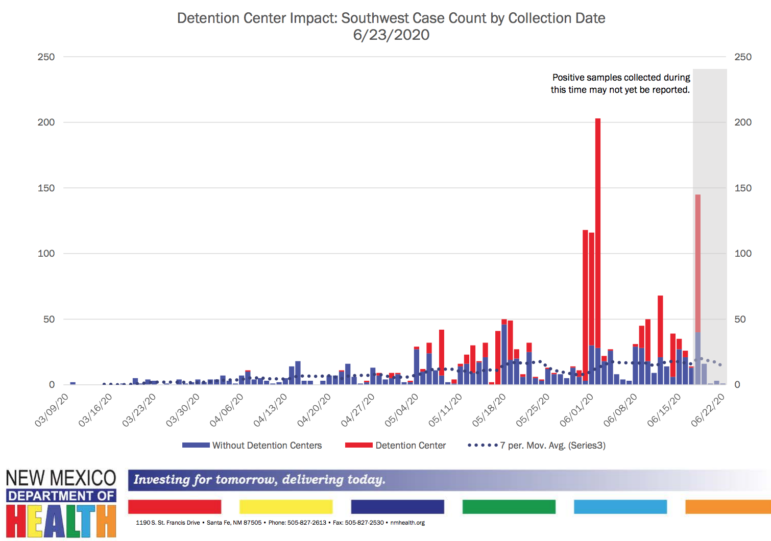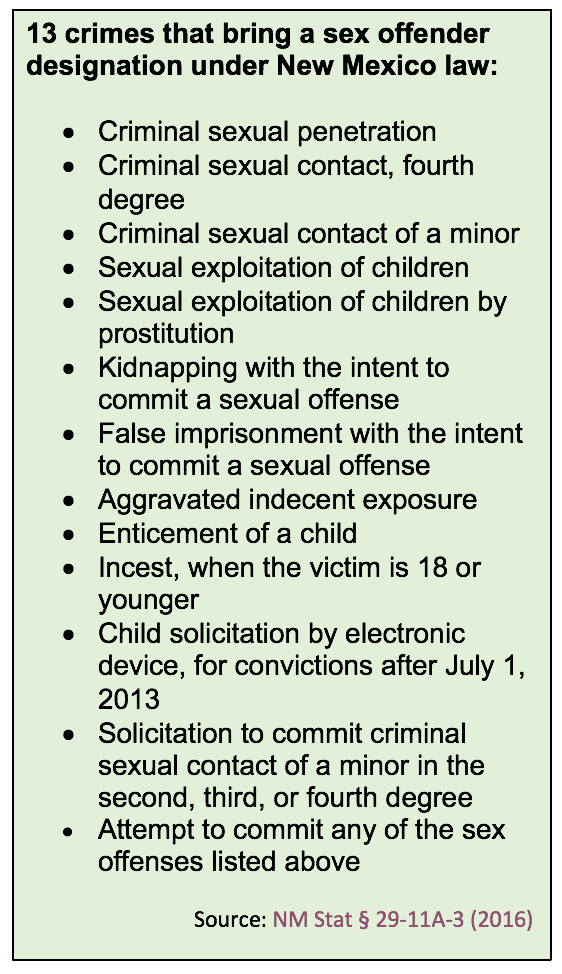As the coronavirus established a foothold in southern New Mexico’s Otero County Prison Facility in mid-May, state officials quietly moved 39 inmates out of the massive complex near the Texas border to another prison near Santa Fe.
The inmates shared something in common: None was a sex offender.
In the days before the 39 departed the massive correctiional complex where New Mexico’s only sex offender treatment program is housed, officials were still transferring sex offenders from other state prisons into Otero. It was a routine practice they had yet to stop, even though more than a dozen COVID-19 cases had already emerged elsewhere in the prison.
Six weeks later, 434 inmates — or 80% — have the virus, within a prison population that’s now entirely composed of people who, at one time or another, were convicted of a state sex offense.
Three have died. Eight more lie ill at University Hospital in El Paso.
One of New Mexico’s most crowded prisons, Otero is the only state lockup with more than one COVID-19 case. And yet no prisoner from the facility has been released early under an executive order issued by Gov. Michelle Lujan Grisham on April 6 because sex offenders are not eligible.
Prisoners from the state’s 10 other facilities have gotten out, however, documents New Mexico In Depth obtained through a public records request show.
The revelations come through more than a week of reporting by New Mexico In Depth, and confirmation from Corrections Department spokesman Eric Harrison.
The timeline of inmate transfers as the virus crept into the prison is “really concerning,” said Lalita Moskowitz, staff attorney with the American Civil Liberties Union of New Mexico.
“It indicates that Corrections knew that there was likely to be an outbreak or that there was some danger or risk to people housed in that facility,” Moskowitz said. “And they made a very clear decision about who in that facility was worth saving during a pandemic, and did so earlier than they were showing any sort of concern to the public.”
State officials didn’t seek to create a sex-offender-only prison purposely by sending the 39 inmates to Santa Fe, Harrison said. Rather, they did it “for COVID reasons,” he said, adding that they had been housed in a separate area of the Otero prison, away from the sex offenders.
“It wasn’t a specific policy change or big decision to make Otero the only sex-offender-only prison,” he said. “After that first inmate tested positive, we needed space to create a quarantine unit.”
As of Thursday, there had been no discussion in the Lujan Grisham administration about revisiting the criteria in the executive order on early release, including the provision excluding sex offenders, Harrison told NMID.
That’s despite the outbreak in Otero County.
“As the state continues to battle COVID, I’m sure that will be something that comes up,” Harrison added.
In the other wing of the Otero County Prison Facility, where federal inmates are detained by agencies including the U.S. Marshals Service and the Department of Homeland Security, 275 prisoners have contracted the virus.
Most are locked up on drug-related charges, officials revealed this week.
Next door at the Otero County Processing Center, where Immigrations and Customs Enforcement detains hundreds of migrants, 146 people have tested positive for the potentially deadly virus.
It is not clear what percentage of the federal prison populations at the Otero facilities are infected because the total number of inmates locked up at the processing center and the federal wing of the prison facility are unknown. Management and Training Corp. (MTC), a private prison company, operates both prisons under contracts with the state and the feds.
Neither MTC nor federal agencies would disclose the total numbers of their detainees in either prison or processing center.
But as of Friday the state held 539 people in its half of the prison facility, when New Mexico officials reported that 434 of them had contracted the virus.
Driving the numbers
For now, grim numbers from Otero roll in each afternoon from the governor’s office, driving not just the rate of infection for incarcerated people, but the state as a whole.
June 5: 129 positive test results for inmates at the Otero County prisons. That was 39 percent of the state’s 331 new infections announced that day.
June 20: 37 percent of new virus cases announced were behind the walls near the Texas border.
June 21: 41 more incarcerated people in Otero County had the virus — 30 percent of the day’s new total.
Already held up in the national press as a state whose approach has saved lives and kept infections relatively low, New Mexico might look even better nationally were it not for the Otero County Processing Center and the Otero County Prison Facility.
At the end of the week 855 people locked up in the two prisons have tested positive for the potentially deadly virus since early May, officials say — nearly 8% of New Mexico’s overall total stretching back to March 11.

An experimental prison
It’s by design that Otero is home to such a large number of incarcerated sex offenders.
New Mexico Corrections Department officials first contracted with MTC to manage a wing of the Otero County Prison Facility in 2013, under then-Gov. Susana Martinez. The plan was to create a sex-offender-only prison and offer treatment to an initial group of inmates, then constantly reevaluate.
Sex offenses, under New Mexico law, range from violent rapes to child exploitation to aggravated indecent exposure.

“There’s a sort of perception that we have in society about who’s a sex offender,” Moskowitz of the ACLU said. “Of course, there are the really serious, violent and child abuse cases. But a lot of people get labeled as a sex offender and required to register who we wouldn’t think of in that way.”
The Otero experiment has produced mixed results and reviews through the years, though corrections officials have continued to feature it as the state’s only prison where the Sex Offender Treatment Program (SOTP) is available.
Steadily, the population has grown to over 500, partly as corrections officials have identified sex offenders in other New Mexico prisons as candidates for the SOTP.
Transfers from around the state to Otero have been a regular feature for years, Harrison, the corrections spokesman, said. They slowed as the pandemic landed in New Mexico in early March, but continued after the outbreak began on the federal side of the building.
“In March, across the board, we really looked at all the facilities and said, ‘Let’s limit inter-facility transfers unless it’s really an as-need basis,” he said. “Once we got that first inmate positive on the state side … once that outbreak hit, that’s when it really came to a halt there at Otero.”
Corrections officials have maintained that there’s a bright line between the state and federal wings of the Otero prison.
“There is never a time where inmates or staff from the state and federal side will cross paths or use shared spaces,” Harrison wrote to NMID in May. “That was not practice previously, and is not practice now.”
Harrison did not say how many inmates had been transferred into Otero in the week between when cases emerged in the federal and state wings of the prison.
It is not at all clear when the COVID-19 outbreak actually began in Otero County — because MTC and the feds have remained tight-lipped about their testing regimens, and state officials did not begin scouring for the virus until at least two months after the pandemic reached New Mexico.
Since 2013, the Corrections Department has maintained a little-known, seldom-discussed 44-bed section for non-sex offenders in the prison.
It sits apart from the main area, but the two sections are laid out the same: “dormitory-style,” with cots for sleeping spaced no more than three feet apart.
State corrections and health officials on Wednesday acknowledged that the close proximity has made containing virus spread in the prison nearly impossible.
Although the 39 non-sex offenders are no longer in that area in Otero, these days the 44-bed unit is being used to quarantine inmates.
The Central New Mexico Correctional Facility in Valencia County features a similar design. But there are some differences in the two prisons: Fourteen inmates have been released early from Central, which is at about 69% of its design capacity and has reported one COVID-19 case for an inmate.
Otero, where no inmates have been released early, was 83% full as of Thursday with 434 infections. (That’s also higher than the current statewide population, which is at about 80% overall capacity.)
‘The person is not a sex offender’
On Wednesday during a virtual news conference, state Corrections and Health department officials addressed the Otero outbreak and acknowledged the transfer of the 39 inmates. They did not elaborate.
Harrison, however, confirmed that the 39 inmates transferred out of Otero last month had been tested before leaving, again once they arrived at the Penitentiary of Santa Fe and again after a 14-day quarantine in Santa Fe. All have tested negative.
The Penitentiary has recorded no COVID-19 case.
Another issue that did not come up at the news conference: No inmates have been released from Otero prior to the end of their sentence under Lujan Grisham’s April 6 executive order, which acknowledges that “social distancing measures” are “the most effective way to prevent the spread of COVID 19.”
The order continues: “The early release of incarcerated individuals who are near their release date and meet certain criteria will help to protect public health without a concomitant risk to public safety.”
To date, 71 of roughly 6,200 inmates have been released under the order statewide — a miniscule figure compared to other states that have sought to reduce prison populations. The low figure has drawn heavy criticism from justice system reformers and civil rights advocates.
The order is far more restrictive than what’s allowed for early release under state law, as New Mexico In Depth has reported previously.
Inmates have been released from each of the state’s other 10 prisons except Otero, the records obtained by NMID show.
Just three of those prisons — in Cibola, Santa Fe and Valencia counties — have seen coronavirus infections, with one case at each of those prisons.
Corrections officials have continued to scan their prison population for people who can be released early, as required by the executive order, Harrison said.
“Every inmate goes through the same review process, and we are conducting those reviews to identify eligible inmates on a regular basis,” he said. “We have released everyone who has been identified. Sex offenders obviously are ineligible.”
The order lists seven criteria for early release: that inmates be within 30 days of the end of their sentence; they must have a parole plan in place; and they must not be serving sentences for domestic abuse, felony DWI, assaulting a police officer or any crime with an added firearm enhancement; and that “the person is not a sex offender.”
There’s a key difference for sex offenders: Anyone who has one of those convictions on their record — even if they’re serving time now for a completely different crime — is excluded from early release under the order.
“It’s interesting to exempt an entire classification of people, not based on the sentence they’re currently serving, but based on a designation that lives with people their whole lives,” Moskowitz of the ACLU said. “It indicates all of the perceptions and ideas and stigmas are carrying into this action that the governor is taking with the idea of saving people’s health and lives.”
Harrison acknowledged that there are inmates at Otero who have past sex offenses, but are incarcerated for something else now.
“Whatever we have decided as a society to do to punish people, regardless of whether we think all of those things are justified or make sense, we as a society have not sentenced people to suffer in a disease-ridden cage,” Moskowitz said.






















